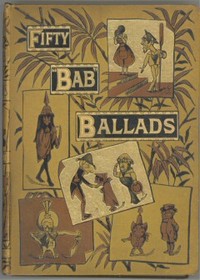Ballad: The Bishop Of Rum-Ti-Foo
byThe Bishop of Rum-Ti-Foo finds himself navigating unfamiliar customs with grace, humor, and heartfelt sincerity. Unlike many who arrive with the intention of reform, Bishop Peter embraces the traditions of his small flock without judgment. His approach, grounded in respect and curiosity, opens the door to a rare and genuine bond between colonizer and native. Rather than preaching rigid doctrine, he meets the people of Rum-ti-Foo where they are—rhythmic, bold, and vibrantly unique. The act of sharing meals, participating in their ceremonies, and dancing to their tum-tum rhythms establishes a spiritual bridge more powerful than any sermon could deliver. Such moments reveal that compassion often speaks louder than ritual. His joy, born of genuine connection, becomes the driving force behind his mission, turning what could have been a comical appointment into a truly transformational experience for all involved.
Upon returning to England, Bishop Peter does not cast aside the life he briefly led. The imprint of Rum-ti-Foo lingers in his heart, not as an exotic adventure, but as a meaningful chapter that reshaped his worldview. Watching the energetic dancer in the streets of London reignites a longing to offer more than theology to his people—he wants to bring joy, movement, and shared laughter. It’s this realization that drives him to master the dance, a gesture of humility and learning. Every misstep he makes on cobbled alleys is an act of love, a preparation to reintroduce himself to Rum-ti-Foo not only as their Bishop but as one of them. Such devotion, though comical on the surface, demonstrates that leadership is not defined by authority but by shared humanity. Through dance, he plans to express what words and rituals could not.
Bishop Peter’s dedication transforms him. Where once he may have seen the dance as mere spectacle, he now views it as a symbol of inclusion and celebration. The people of Rum-ti-Foo, initially amused, grow to admire his effort. In every practiced twirl and carefully timed rhythm, they sense his sincerity. They see not a bishop from a distant land, but someone who honors their way of life. The laughter that follows is not mocking but communal, shared in the warmth of cultural embrace. Peter’s willingness to learn their joy becomes his greatest sermon, preached not from a pulpit but through his willingness to look silly in the name of kinship. The island’s tum-tum drums now pulse in time with his heartbeat, and the boundaries between leader and follower blur in a dance of mutual respect.
What began as satire evolves into a quiet commentary on acceptance and transformation. The Bishop, with his clerical robes and foreign sensibilities, is not stripped of identity—he is expanded by his encounter with Rum-ti-Foo. In many ways, the people convert him, softening the edges of his formality with their bold expressions of life. He does not lose his faith but deepens it, now grounded in the rhythms of a culture he once saw as distant. The image of the Bishop dancing at dawn, surrounded by smiling villagers, becomes a parable not of mockery but of harmony. Cultural bridging often requires vulnerability, a willingness to appear foolish, and a commitment to stepping outside one’s comfort zone. Peter’s journey through laughter, discomfort, and dance reminds us that leadership thrives where empathy leads.
Moreover, this ballad cleverly critiques colonial tendencies without becoming bitter. Through the Bishop’s earnest efforts, it reveals a possible path toward mutual understanding, one paved with more humility than hubris. Humor does not deflate the lesson—it elevates it. In a world quick to judge or divide, the Bishop of Rum-ti-Foo teaches that connection doesn’t always need translation. Sometimes, a dance—awkward, joyful, and shared—is enough to remind us that underneath layers of difference, the desire to belong and to be understood is universal. His tale is not merely whimsical; it’s a call to approach the unfamiliar not with suspicion, but with open arms and a willingness to twirl.

